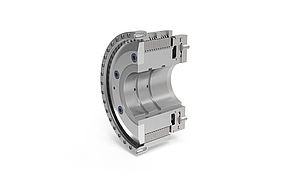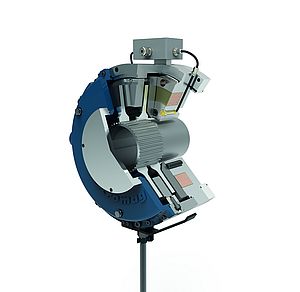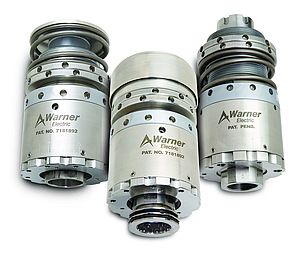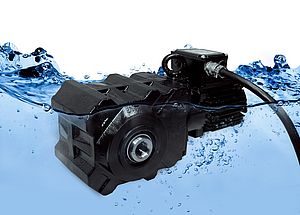Companies that upgrade their pumping systems, or install new systems, both with the objective of improving efficiency, commit themselves to substantial investment, not only in terms of the pumps themselves, but also with new energy efficient motors to drive them. However, these investments can easily be wasted if the pump/motor combination is not integrated in a way that not only maximises the respective pump and motor efficiencies, but also protects the combined equipment from normal wear and tear.
Achieving the optimum pump/motor interface would not be a problem if driving and driven shafts were perfectly aligned, if machines didn’t vibrate, and if the shafts never actually moved. They don’t meet any of these criteria, however; which is why, in the real world of power transmission, flexible couplings are required that can accommodate the flaws and dynamics inherent in most systems.
With coupling selection, pump users should always beware of the obvious trap: namely, “that more is better”. It isn’t. Oversizing a flexible coupling can result in a reduction in required flexibility or misalignment compensation; and a coupling that is too large can put additional stresses on the pumps and motors being coupled. On the other hand, a flexible coupling with too much misalignment capacity may be too soft or too “compliant”, which can cause vibration or an unbalanced condition in rotation.
With these pitfalls firmly in mind, the pump user is equipped to undertake a selection procedure that essentially depends upon four basic conditions of shaft misalignment, or movement.
• First, Parallel misalignment, which occurs when the two shafts do not share the same axis of rotation.
• Second, Angular misalignment; this applies when shafts are neither coaxial nor parallel.
• Third, End float; a condition that occurs when either or both shafts display axial movement, moving in and out.
• Fourth, Torsional flexibility; which is the torsional movement in planes perpendicular to the shaft axis. It is typically caused by shock or vibration. A torsionally- flexible coupling absorbs and dampens these movements.
To be considered flexible, a coupling must handle parallel and angular misalignment. In addition, couplings with four-way flexibility additionally accommodate both end float and torsional movement. The basic construction of these types of couplings consists of two flanges or hubs, which attach to the shafts being coupled, and a connecting element that may be metallic, such as in disc couplings; it may also be a sleeve made from elastomeric material, such as EPDM rubber, neoprene, Hytrel or urethane, or it may be mechanical as in a u-joint or gear coupling.
Four-way flexibility
An excellent example of a four-way flexible coupling with good torsional flexibility is an elastomeric coupling that operates in shear (as opposed to compression). The design of these couplings enables the elastomeric flexible member to deform, or stretch, in shear, displacing under a load. The amount of torsional displacement or “windup” of the elastomer is a measure of the shock that can be absorbed. It also compresses easily and stretches to handle end float.
The torsional flexibility of elastomeric shear couplings provides operating protection for the pump user. It dampens the amplitude of vibrations, isolating one shaft from the effects of the other. In effect, the energy absorbed during shock loads is used to wind the elastomer in a twisting action. Since the force of the shock from the motor is reduced by the amount of energy expended in winding the flexible member, the pump shaft is cushioned from the shock. This energy is then released back into the drive system as the coupling unwinds. This protective measure is complemented by the fact that elastomeric shear couplings are designed to fail under excessive shock loads, disconnecting the pump from the motor to protect the pump from serious damage.
In contrast to elastomeric couplings that are operated in shear, couplings that employ elastomeric material in compression don’t have the same amount of misalignment capacity or axial or torsional dampening capabilities. This is due to the fact that, in compression, the rubber element is being squeezed, rather than twisted, to transmit torque.
“The molecular structure of the elastomer material in shear couplings is highly engineered because the material has to be much stronger to withstand shear forces,” said Paul Konkol, Marketing and Business Development Manager, Industrial Couplings, for Altra Industrial Motion. “I liken it to the difference between cast metal and forged steel where, in forging, you basically align the molecular structure to make the material stronger.”
Couplings for high torque, high speed
Whilst elastomeric couplings are popular for many general industrial pump applications operating up to 85.75Kw /100 rpm, the limits of elastomeric materials are exceeded in applications that require transmission of higher torques and speeds. Gear, grid and disc couplings are metallic couplings that are more torsionally rigid and offer advantages in these applications.
"Gear and grid couplings are excellent with higher torques, but as with anything, when you make gains in one area of design, there are things you have to give up in other areas,” said Konkol. “In this case, it is torsional dampening. These are stiffer couplings so more vibration is going to be transmitted through to the pump.”
Gear couplings are constructed with a sleeve containing internal teeth that mesh with teeth on the outside of the hubs. Popular for high-speed, high power and high-torque, low-speed applications, they work well in applications that require torsional rigidity. The fit of the teeth in a gear coupling allows for misalignment, but the degree of compensation of angular misalignment depends on the contour of the gear teeth and the clearance between them. Because of their design, these torsionally stiff couplings can withstand some shock loading, but not in significant amounts.
Grid couplings consist of two grooved flanged hubs connected by a tapered steel spring in the form of a grid. In common with gear couplings, they require lubrication, but allow for flexibility and efficiency at high speeds, or at low speeds with high torque. Grid couplings can operate at up to 298Kw/100 RPM. Being more rigid, their misalignment capabilities are not as great as elastomeric couplings, thus alignment of the motor and pump shafts is more critical.
Disc couplings are extremely uniform in design and can rotate at very high speeds – up to 3,000 rpm, or higher, when used with turbine-driven equipment. Pumps operating at high rpm are good applications for these well-balanced, smooth operating devices that, like elastomeric couplings, require no lubrication. Disc couplings, however, are quite complex designs and are extremely sensitive to misalignment and axial movement. Flexing of a disc or metallic component beyond its yield point can cause fatigue, and axial movement can cause failure.




























